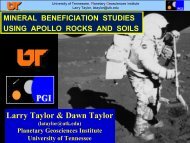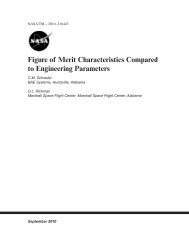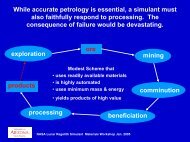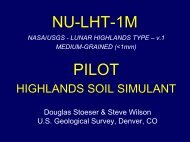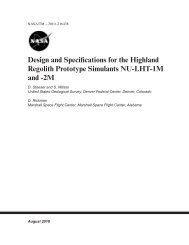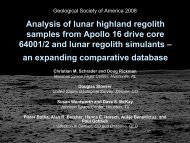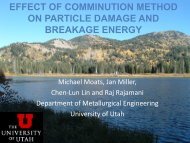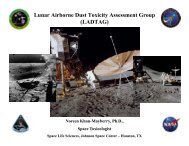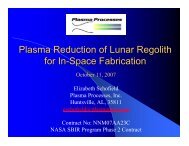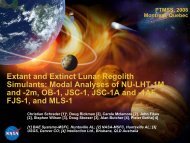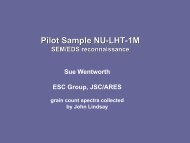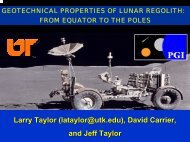Book of Abstracts- Lunar Regolith Simulant Materials Workshop
Book of Abstracts- Lunar Regolith Simulant Materials Workshop
Book of Abstracts- Lunar Regolith Simulant Materials Workshop
You also want an ePaper? Increase the reach of your titles
YUMPU automatically turns print PDFs into web optimized ePapers that Google loves.
is also a fundamental property but for regions below 3<br />
m no direct data about the density <strong>of</strong> the lunar regolith<br />
exists [2].<br />
Mechanical Properties <strong>of</strong> Dust: The standard<br />
properties identified in soil mechanics may be required:<br />
compressibility, shear strength, permeability,<br />
bearing capacity, slope stability, and trafficability.<br />
In addition, we will investigate the effects <strong>of</strong> extreme<br />
vacuum and temperature environment on these properties.<br />
Under extreme environment, the interaction between<br />
dust and metallic surfaces may be unexpectedly<br />
altered and should also be investigated. This includes<br />
the investigation <strong>of</strong> tribocharging due to particleparticle<br />
interactions and also particle interaction<br />
against other surfaces. Due to insulating nature <strong>of</strong> the<br />
surface <strong>of</strong> the Moon, once the charge is accumulated,<br />
the discharge is expected to be a serious problem.<br />
Grounding will be investigated in conjunction with<br />
weakly conductive coating.<br />
Shaking the Space Suit: an example <strong>of</strong> mitigation<br />
strategy: It was reported many times that the<br />
conventional “brushing-<strong>of</strong>f” the dust never worked<br />
once the dust adhered to the Apollo astronauts’ suit.<br />
Many dust removal methods have been suggested,<br />
including the possibility <strong>of</strong> manufacturing new fabric<br />
that possesses repelling capability at nanoscale. Manufacturing<br />
new materials will be the ultimate solution.<br />
In parallel to the development <strong>of</strong> the potential dust<br />
repelling materials, we will pursue several dust removal<br />
techniques including shaking, airbrushing, and<br />
electrostatic/magnetic wands sweep. This paper shows<br />
our preliminary approach <strong>of</strong> dust removal by shaking<br />
that was initiated by two undergraduate students from<br />
Colorado School <strong>of</strong> Mines who participated in the<br />
2004 summer internship program <strong>of</strong>fered by the<br />
NASA-Glenn research center.<br />
When removing sand on a beach towel, we usually<br />
first shake it giving a large sinusoidal motion. This<br />
removes most sand grains with the help <strong>of</strong> significant<br />
gravitational pull. At a closer look at the towel, however,<br />
you will notice smaller sand grains embedded in<br />
the towel fabric. These are usually removed by washing<br />
with the help <strong>of</strong> surfactant influenced fluid motion.<br />
On the surface <strong>of</strong> the Moon or Mars, we do not anticipate<br />
the luxury <strong>of</strong> using water to wash <strong>of</strong>f dust every<br />
time an astronaut returns to his/her habitat. The question<br />
<strong>of</strong> releasing fine dust from the beach towel will<br />
still remain as a problem there. We pursued very localized<br />
shaking <strong>of</strong> fabric after a general shake. Different<br />
modes <strong>of</strong> local shaking were tried. We arrived at a<br />
conclusion that a mixed mode between vertical and<br />
horizontal shaking should produce the results we expect.<br />
To accomplish this task at a preliminary stage, a<br />
small motor used to vibrate a cell phone was used. It<br />
seemed to release fine dust effectively. However, after<br />
a closer look at the dust-contaminated fabric under the<br />
microscope, we found finer dust still adhered to the<br />
fabric even after magnetic sweep (Fig.3).<br />
A series <strong>of</strong> preliminary experimental data will be<br />
shown at the time <strong>of</strong> presentation.<br />
Fig. 3. A magnified view <strong>of</strong> the space<br />
suit fabric contaminated by dust.<br />
Acknowledgements: MN would like to thank<br />
Mike Duke and the team members <strong>of</strong> the Project Dust<br />
for their enthusiastic support to the project.<br />
References: [1] Peter Eckert, editor (1999) The<br />
<strong>Lunar</strong> Base Handbook: An Introduction to <strong>Lunar</strong> Base<br />
Design, Development, and Operations. The McGraw-<br />
Hill Companies, Inc. [2] G. Heiken, D. Vaniman and<br />
B. French (1991) <strong>Lunar</strong> Sourcebook-A Users Guide to<br />
the Moon. Cambridge University Press.<br />
20



